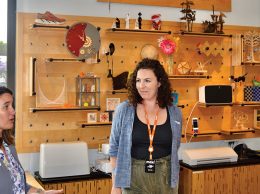MOXI museum could spark revival on lower State Street
IN THIS ARTICLE
- Columns Topic
- Elijah Brumback Author
By Elijah Brumback Friday, March 27th, 2015

Elijah Brumback
MOXI, the Wolf Museum of Exploration and Innovation, is probably one of the most anticipated developments in Santa Barbara in the last decade.
The foundation for the new 25,000-square-foot, LEED-certified children’s museum was recently laid, and the organization announced its new CEO, Steve Hinkley.
The project, which will focus on science, technology, engineering, arts and math-based interactive exhibits, includes a rooftop garden, smart classroom, new media theater and a museum store.
Geared toward children between ages three and 12 and scheduled to open in late 2016, the museum is expected to draw upwards of 95,000 visitors annually.
The city has been salivating over the Wolf Museum’s impact. Increased foot traffic could help the revitalization of lower State Street, which has fallen behind other parts of downtown.
Coupled with the rebooted efforts to get the La Entrada hotel development moving forward, area restaurants and retailers should expect a significant uptick in business, Hinkley said.
“The museum will draw a lot of people toward the lower State area,” he said. “That means a lot of families with young kids, many of which will be staying at the hotels and visiting the restaurants. In addition to the local community, we’ll definitely have a draw with the tourist population.”
Hinkley was previously the vice president of programs at the Perot Museum of Nature and Science in Dallas, Texas. When the museum — which now draws 1.2 million visitors annually — first opened, Hinkley said there was a massive increase in activity for business within a two- to three-block radius. Sales at businesses around the museum increased 20 to 30 percent, he said.
“Right now there is a great confluence of activity where we are at,” Hinkley told the Business Times. “I think the area is going to look completely different over the next couple of years.”
The museum is also positioning itself to become one the city’s prominent event spaces thanks to its central location and amenities.
As the museum’s opening gets closer, the organization is trying to cap its $25 million capital campaign and is gearing up to enter the public phase of its fundraising efforts.
According to the Association of Children’s Museums, more than 30 percent of youth museums are part of a downtown revitalization project. ACM also notes the total economic activity of its children’s museum members is estimated at $448 million. Additionally, more than 30 million individuals visit children’s museums around the world each year.
While MOXI is on the small side, the relative impact should be measurable one that should spur developers to start lining up financing for future projects and push retailers to fill up the number of vacant store fronts in the area.
Fresh & Easy cuts its losses
Four Fresh & Easy locations in Ventura County are closing down as the grocery chain looks to sell off about 30 percent of its stores.
According to a release from the company, the move is part of a plan to finance new development and growth, including a new 3,000- to 5,000-square-foot concept store. Fresh & Easy is working with Apple store designer ADMI on the new fresh food project.
Among the locations closing are stores in Newbury Park, Camarillo, Oxnard and Ventura. They will all be put up for sale.
The chain was British supermarket giant Tesco’s first venture into the U.S. market. The company spent $2 billion trying to transplant its British retail format with private-label products and little to no service.
In 2013, Fresh & Easy filed for Chapter 11 bankruptcy protection after operating for several years without earning a profit. The grocery chain was later sold to Yucaipa Cos., owned by grocery industry billionaire Ron Burkle.
SLO fund to help NEW project
Infrastructure investment in San Luis Obispo got a boost from a collaboration between chamber leaders and city officials recently, with the partners coming together to form a new development fund.
With $60,000 in seed money and possibly more to come, the Infrastructure Investment Capital Fund is meant to be used as a resource to leverage grant funding for economic development, as a loan fund for private developers that facilitates priority infrastructure and for the city to invest in opportunities that it deems will further economic development and quality of life.
Projects eligible for investment will be evaluated based on criteria that include head-of-household job creation, housing, circulation improvements and public benefit.











